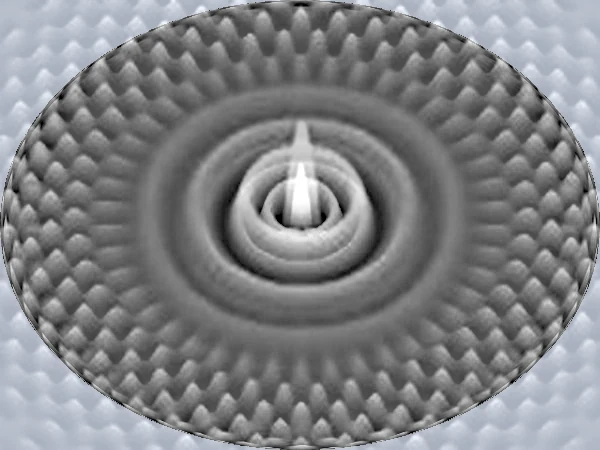
Imagine an electron as a light mist spread through space rather than a well-localized marble in time. Even with the best microscopes or the most powerful calculations, you will never be able to point to it and say: "It's there!" The great quantum mystery is that at the moment of measurement, it "chooses" an exact position, as if all the mist suddenly condensed into a drop of water.
This strange dance between blur and precision is at the heart of the quantum revolution. In quantum mechanics, the electron is not described as a corpuscle but as a wave function \(\psi(r,t)\) introduced by Erwin Schrödinger (1887-1961). This function encodes the probability density \(|\psi|^2\), which gives the chance of finding the electron at a given position. The image of a probability cloud thus replaces the classical idea of a well-defined trajectory.
The wave function is not an extended physical reality but a probabilistic prediction tool, as Niels Bohr (1885-1962) stated in the Copenhagen school. However, during a measurement—for example, on a fluorescent screen—the electron is detected at a precise point, like a particle. This phenomenon is called wave packet reduction.
N.B.:
The charge of the electron is a fundamental constant of physics, denoted as −e (or −1.602176634 × 10−19 Coulomb in absolute value). It represents the smallest observable quantity of free electric charge in nature. This value, measured with extreme precision, is the basis of quantum electrodynamics and defines the unit of charge in the International System (SI) since the 2019 redefinition, where the coulomb is now linked to the elementary charge via Planck's constant. Practical equivalence: 1 C ≈ charge of 6.24 trillion trillion electrons.
Unlike Newtonian mechanics, where position and velocity are simultaneously defined, Werner Heisenberg's (1901-1976) uncertainty principle states that \(\Delta x \cdot \Delta p \geq \hbar / 2\). This implies that the more we know the electron's position (x), the less we know its momentum (p), and vice versa.
| Aspect | Classical Particle | Quantum Particle | Comment |
|---|---|---|---|
| Position | Well-defined in space at any moment | Probabilistic (\(|\psi|^2\)) | Quantum mechanics does not give an exact position but a probability cloud: for example, 5% chance of detecting it at A, 25% at B, etc. Only a measurement "randomly selects" the actual position among these possibilities |
| Trajectory | Continuous line in spacetime | Interferences, superpositions | No pre-traced path: the particle simultaneously explores multiple possible paths, like waves crossing and influencing each other, creating a landscape of probabilities |
| Measurement | Does not affect the state | Collapse of the wave function | Measurement induces a reduction of the wave packet: the particle's superposed state collapses into a single value at the moment of interaction with the measuring device |
Quantum mechanics is not limited to electrons! Its rules apply to all fundamental particles (photons, quarks, neutrinos) but also to much larger objects than one might imagine. Yet a question remains: Where does the quantum realm end? The surprising answer: there is no theoretical limit... only technical challenges to observe these effects on a large scale.
Experiments confirm that even complex molecules (such as buckminsterfullerene, a molecule of 60 carbon atoms) can exhibit wave-like behaviors. In 2019, physicists observed interference with molecules of 2,000 atoms—a record! These objects, though massive, obey quantum laws as long as they remain isolated from their environment (no collisions, heat, or intrusive measurements).
Experiments with giant molecules use high-vacuum chambers to avoid any parasitic interaction. Experiments with organic molecules work at room temperature if the observation time is ultra-short (nanoseconds). Experiments with macroscopic systems, such as the superconducting circuits of quantum computers, use cryogenics (−273.15°C or 0 Kelvin).
So why don't we see humans in a "superposition of states"? Because of decoherence: as soon as a quantum system interacts with its environment (air, light, heat), its "magical" properties (superposition, entanglement) disappear almost instantly.
| System | Typical Coherence Duration | Comment |
|---|---|---|
| Electron | Hours (in vacuum) | Elementary particle almost isolated: low coupling with the environment, high quantum stability |
| Simple Molecule (H2, CO) | Milliseconds | Vibrational and rotational interactions induce rapid loss of coherence |
| Fullerene Molecule (C60) | Microseconds | Interference experiments (Arndt & Zeilinger, 1999) show that objects with dozens of atoms remain quantum briefly |
| Complex Organic Molecule (peptide, protein) | A few nanoseconds | Internal complexity increases degrees of freedom and accelerates decoherence |
| Virus | <10−12 s | Complete biological object: internal and environmental interactions destroy coherence almost instantly |
N.B.:
The quantum coherence duration decreases sharply with the size and temperature of a system. In other words, the larger and more thermally agitated an object is, the faster it shifts to classical behavior.
The quantum description is universal, but its effects become invisible when objects become too complex or too connected to their environment. The real question is not "how far?" but "how to protect quantum fragility?"